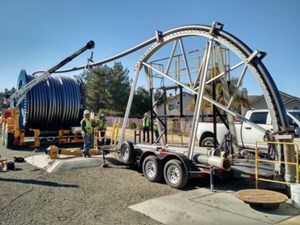Austin Energy underground powerline study granted approval in city council budget
AUSTIN (UI) — In the early months of the year, Central Texas bore the brunt of Winter Storm Mara, an ice storm that left a trail of destruction in its wake. The repercussions of this storm were severe: over 174,000 Austin Energy customers lost power, and the impact was long-lasting, with extended outages for weeks due to the extensive damage sustained by powerlines, KVUE reported.
Responding to this crisis, the Austin City Council took action this week, earmarking $1 million for a comprehensive study. The objective of this study is to assess the feasibility of transitioning more of Austin Energy's powerlines underground.
Reflecting on the urgency of this initiative, Matt Mitchell, the public information officer for Austin Energy, told KVUE, "It was something that has been a priority for the utility for some time, and it takes on a greater sense of urgency after Mara. It just does."
Currently, a significant portion—57%—of Austin Energy's power lines are already situated underground. However, the focus of this study is the remaining 5,000 miles of above-ground lines. The analysis aims to identify economically and environmentally viable areas for the transition.
Dr. Michael Webber, an Energy Resource Professor at the University of Texas at Austin, emphasized the importance of this study, noting that not all areas are suitable for an underground line system due to factors like soil type, terrain, and local risks.
The challenges associated with underground lines are acknowledged. While they offer increased resilience due to their protection from above-ground elements, they are also more complex to repair since they require excavation. The cost factor further amplifies the complexity, with estimates indicating that burying just one mile of power lines could range between $3 to $5 million. With approximately 5,000 miles to consider, the potential cost stretches into the billions over a span of decades.
Austin Energy's plan is strategic and gradual, as they intend to implement changes based on the study's results. The envisioned transformation is a multi-year, multi-decade effort that will unfold in phases. A choice engineering firm is soon to be selected to spearhead the study, with expectations for swift commencement once decided.
The study's conclusions are anticipated to be unveiled by 2024.
In the grand scheme of things, this undertaking is seen as a prudent long-term investment for the city. Dr. Webber highlighted the advantages of underground lines, acknowledging their higher upfront costs but emphasizing their long-term benefits in terms of reliability and aesthetics. As Austin Energy sets its sights on a future powered by resilient and visually appealing infrastructure, the journey is poised to begin in earnest.
Related News
From Archive

- Glenfarne Alaska LNG targets late-2026 construction start for 807-mile pipeline project
- U.S. water reuse boom to fuel $47 billion in infrastructure spending through 2035
- $2.3 billion approved to construct 236-mile Texas-to-Gulf gas pipeline
- Major water pipe break in Puerto Rico hits over 165,000 customers
- Potomac River Tunnel project enters construction phase beneath Washington, D.C.
- Pennsylvania American Water launches interactive map to identify, replace lead water service lines
- Trump's tariffs drive $33 million cost increase for Cincinnati sewer project
- Utah city launches historic $70 million tunnel project using box jacking under active rail line
- Tulsa residents warned after sewer lines damaged by boring work
- Fatal trench collapse halts sewer construction in Massachusetts; two workers hospitalized




Comments